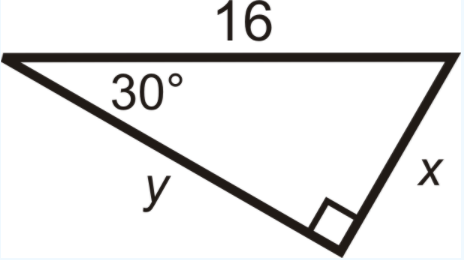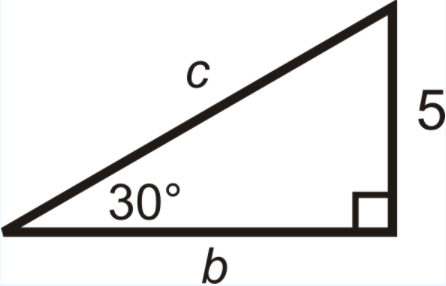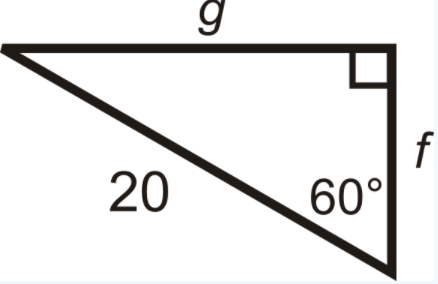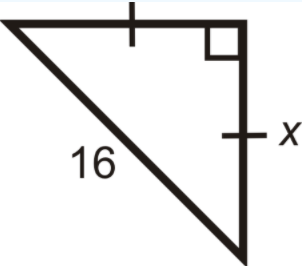1.2: Special Right Triangles
\newcommand{\vecs}[1]{\overset { \scriptstyle \rightharpoonup} {\mathbf{#1}} }
\newcommand{\vecd}[1]{\overset{-\!-\!\rightharpoonup}{\vphantom{a}\smash {#1}}}
\newcommand{\id}{\mathrm{id}} \newcommand{\Span}{\mathrm{span}}
( \newcommand{\kernel}{\mathrm{null}\,}\) \newcommand{\range}{\mathrm{range}\,}
\newcommand{\RealPart}{\mathrm{Re}} \newcommand{\ImaginaryPart}{\mathrm{Im}}
\newcommand{\Argument}{\mathrm{Arg}} \newcommand{\norm}[1]{\| #1 \|}
\newcommand{\inner}[2]{\langle #1, #2 \rangle}
\newcommand{\Span}{\mathrm{span}}
\newcommand{\id}{\mathrm{id}}
\newcommand{\Span}{\mathrm{span}}
\newcommand{\kernel}{\mathrm{null}\,}
\newcommand{\range}{\mathrm{range}\,}
\newcommand{\RealPart}{\mathrm{Re}}
\newcommand{\ImaginaryPart}{\mathrm{Im}}
\newcommand{\Argument}{\mathrm{Arg}}
\newcommand{\norm}[1]{\| #1 \|}
\newcommand{\inner}[2]{\langle #1, #2 \rangle}
\newcommand{\Span}{\mathrm{span}} \newcommand{\AA}{\unicode[.8,0]{x212B}}
\newcommand{\vectorA}[1]{\vec{#1}} % arrow
\newcommand{\vectorAt}[1]{\vec{\text{#1}}} % arrow
\newcommand{\vectorB}[1]{\overset { \scriptstyle \rightharpoonup} {\mathbf{#1}} }
\newcommand{\vectorC}[1]{\textbf{#1}}
\newcommand{\vectorD}[1]{\overrightarrow{#1}}
\newcommand{\vectorDt}[1]{\overrightarrow{\text{#1}}}
\newcommand{\vectE}[1]{\overset{-\!-\!\rightharpoonup}{\vphantom{a}\smash{\mathbf {#1}}}}
\newcommand{\vecs}[1]{\overset { \scriptstyle \rightharpoonup} {\mathbf{#1}} }
\newcommand{\vecd}[1]{\overset{-\!-\!\rightharpoonup}{\vphantom{a}\smash {#1}}}
\newcommand{\avec}{\mathbf a} \newcommand{\bvec}{\mathbf b} \newcommand{\cvec}{\mathbf c} \newcommand{\dvec}{\mathbf d} \newcommand{\dtil}{\widetilde{\mathbf d}} \newcommand{\evec}{\mathbf e} \newcommand{\fvec}{\mathbf f} \newcommand{\nvec}{\mathbf n} \newcommand{\pvec}{\mathbf p} \newcommand{\qvec}{\mathbf q} \newcommand{\svec}{\mathbf s} \newcommand{\tvec}{\mathbf t} \newcommand{\uvec}{\mathbf u} \newcommand{\vvec}{\mathbf v} \newcommand{\wvec}{\mathbf w} \newcommand{\xvec}{\mathbf x} \newcommand{\yvec}{\mathbf y} \newcommand{\zvec}{\mathbf z} \newcommand{\rvec}{\mathbf r} \newcommand{\mvec}{\mathbf m} \newcommand{\zerovec}{\mathbf 0} \newcommand{\onevec}{\mathbf 1} \newcommand{\real}{\mathbb R} \newcommand{\twovec}[2]{\left[\begin{array}{r}#1 \\ #2 \end{array}\right]} \newcommand{\ctwovec}[2]{\left[\begin{array}{c}#1 \\ #2 \end{array}\right]} \newcommand{\threevec}[3]{\left[\begin{array}{r}#1 \\ #2 \\ #3 \end{array}\right]} \newcommand{\cthreevec}[3]{\left[\begin{array}{c}#1 \\ #2 \\ #3 \end{array}\right]} \newcommand{\fourvec}[4]{\left[\begin{array}{r}#1 \\ #2 \\ #3 \\ #4 \end{array}\right]} \newcommand{\cfourvec}[4]{\left[\begin{array}{c}#1 \\ #2 \\ #3 \\ #4 \end{array}\right]} \newcommand{\fivevec}[5]{\left[\begin{array}{r}#1 \\ #2 \\ #3 \\ #4 \\ #5 \\ \end{array}\right]} \newcommand{\cfivevec}[5]{\left[\begin{array}{c}#1 \\ #2 \\ #3 \\ #4 \\ #5 \\ \end{array}\right]} \newcommand{\mattwo}[4]{\left[\begin{array}{rr}#1 \amp #2 \\ #3 \amp #4 \\ \end{array}\right]} \newcommand{\laspan}[1]{\text{Span}\{#1\}} \newcommand{\bcal}{\cal B} \newcommand{\ccal}{\cal C} \newcommand{\scal}{\cal S} \newcommand{\wcal}{\cal W} \newcommand{\ecal}{\cal E} \newcommand{\coords}[2]{\left\{#1\right\}_{#2}} \newcommand{\gray}[1]{\color{gray}{#1}} \newcommand{\lgray}[1]{\color{lightgray}{#1}} \newcommand{\rank}{\operatorname{rank}} \newcommand{\row}{\text{Row}} \newcommand{\col}{\text{Col}} \renewcommand{\row}{\text{Row}} \newcommand{\nul}{\text{Nul}} \newcommand{\var}{\text{Var}} \newcommand{\corr}{\text{corr}} \newcommand{\len}[1]{\left|#1\right|} \newcommand{\bbar}{\overline{\bvec}} \newcommand{\bhat}{\widehat{\bvec}} \newcommand{\bperp}{\bvec^\perp} \newcommand{\xhat}{\widehat{\xvec}} \newcommand{\vhat}{\widehat{\vvec}} \newcommand{\uhat}{\widehat{\uvec}} \newcommand{\what}{\widehat{\wvec}} \newcommand{\Sighat}{\widehat{\Sigma}} \newcommand{\lt}{<} \newcommand{\gt}{>} \newcommand{\amp}{&} \definecolor{fillinmathshade}{gray}{0.9}Learning Objectives
- Recognize Special Right Triangles.
- Use the special right triangle rations to solve special right triangles.
30-60-90 Right Triangles
Hypotenuse equals twice the smallest leg, while the larger leg is \sqrt{3} times the smallest.
One of the two special right triangles is called a 30-60-90 triangle, after its three angles.
30-60-90 Theorem: If a triangle has angle measures 30^{\circ}, 60^{\circ} and 90^{\circ}, then the sides are in the ratio x: x\sqrt{3}:2x.
The shorter leg is always x, the longer leg is always x\sqrt{3}, and the hypotenuse is always 2x. If you ever forget these theorems, you can still use the Pythagorean Theorem.
What if you were given a 30-60-90 right triangle and the length of one of its side? How could you figure out the lengths of its other sides?
Example \PageIndex{1}
Find the value of x and y.
 Figure \PageIndex{1}
Figure \PageIndex{1}Solution
We are given the longer leg.
\begin{aligned} x\sqrt{3} &=12 \\ x&=12\sqrt{3}\cdot \dfrac{\sqrt{3}}{\sqrt{3}}=12\dfrac{\sqrt{3}}{3}=4\sqrt{3} \\ &\text{The hypotenuse is} \\ y&=2(4\sqrt{3})=8\sqrt{3} \end{aligned}
Example \PageIndex{2}
Find the value of x and y.
 Figure \PageIndex{2}
Figure \PageIndex{2}
Solution
We are given the hypotenuse.
\begin{aligned} 2x&=16 \\ x&=8 \\ \text{The longer leg is} \\ y&=8\cdot \sqrt{3}&=8\sqrt{3} \end{aligned}
Example \PageIndex{3}
Find the length of the missing sides.
 Figure \PageIndex{3}
Figure \PageIndex{3}
Solution
We are given the shorter leg. If x=5, then the longer leg, b=5\sqrt{3}, and the hypotenuse, c=2(5)=10.
Example \PageIndex{4}
Find the length of the missing sides.
 Figure \PageIndex{4}
Figure \PageIndex{4}
Solution
We are given the hypotenuse. 2x=20, so the shorter leg, f=\dfrac{20}{2}=10, and the longer leg, g=10\sqrt{3}.
Example \PageIndex{5}
A rectangle has sides 4 and 4\sqrt{3}. What is the length of the diagonal?
Solution
If you are not given a picture, draw one.
 Figure \PageIndex{5}
Figure \PageIndex{5}The two lengths are x, x\sqrt{3}, so the diagonal would be 2x, or 2(4)=8.
If you did not recognize this is a 30-60-90 triangle, you can use the Pythagorean Theorem too.
\begin{aligned} 4^2+(4\sqrt{3})^2&=d^2 \\ 16+48&=d^2 \\ d=\sqrt{64}&=8 \end{aligned}
Review
- In a 30-60-90 triangle, if the shorter leg is 5, then the longer leg is __________ and the hypotenuse is ___________.
- In a 30-60-90 triangle, if the shorter leg is x, then the longer leg is __________ and the hypotenuse is ___________.
- A rectangle has sides of length 6 and 6\sqrt{3}. What is the length of the diagonal?
- Two (opposite) sides of a rectangle are 10 and the diagonal is 20. What is the length of the other two sides
45-45-90 Right Triangles
A right triangle with congruent legs and acute angles is an Isosceles Right Triangle. This triangle is also called a 45-45-90 triangle (named after the angle measures).
 Figure \PageIndex{6}
Figure \PageIndex{6}\Delta ABC is a right triangle with m\angle A=90^{\circ}, \overline{AB} \cong \overline{AC} and m\angle B=m\angle C=45^{\circ}.
45-45-90 Theorem: If a right triangle is isosceles, then its sides are in the ratio x:x:x\sqrt{2}. For any isosceles right triangle, the legs are x and the hypotenuse is always x\sqrt{2}.
What if you were given an isosceles right triangle and the length of one of its sides? How could you figure out the lengths of its other sides?
Example \PageIndex{6}
Find the length of x.

Solution
Use the x:x:x\sqrt{2} ratio.
Here, we are given the hypotenuse. Solve for x in the ratio.
\begin{aligned} x\sqrt{2} =16\\ x=16\sqrt{2}\cdot \dfrac{\sqrt{2}}{\sqrt{2}}=\dfrac{16\sqrt{2}}{2}=8\sqrt{2} \end{aligned}
Example \PageIndex{7}
Find the length of x, where x is the hypotenuse of a 45-45-90 triangle with leg lengths of 5\sqrt{3}.
Solution
Use the x:x:x\sqrt{2} ratio.
x=5\sqrt{3}\cdot\sqrt{2}=5\sqrt{6}
Example \PageIndex{8}
Find the length of the missing side.
 Figure \PageIndex{8}
Figure \PageIndex{8}Solution
Use the x:x:x\sqrt{2} ratio. TV=6 because it is equal to ST. So, SV=6 \cdot \sqrt{2}=6\sqrt{2}.
Example \PageIndex{9}
Find the length of the missing side.
 Figure \PageIndex{9}
Figure \PageIndex{9}Solution
Use the x:x:x\sqrt{2} ratio. AB=9\sqrt{2} because it is equal to AC. So, BC=9\sqrt{2}\cdot\sqrt{2}=9\cdot 2=18.
Example \PageIndex{10}
A square has a diagonal with length 10, what are the lengths of the sides?
Solution
Draw a picture.
We know half of a square is a 45-45-90 triangle, so 10=s\sqrt{2}.
\begin{aligned} s\sqrt{2}&=10 \\ s&=10\sqrt{2}\cdot \dfrac{\sqrt{2}}{\sqrt{2}}=\dfrac{10\sqrt{2}}{2}=5\sqrt{2} \end{aligned}
Review
- In an isosceles right triangle, if a leg is 4, then the hypotenuse is __________.
- In an isosceles right triangle, if a leg is x, then the hypotenuse is __________.
- A square has sides of length 15. What is the length of the diagonal?
- A square’s diagonal is 22. What is the length of each side?
Resources
Vocabulary
| Term | Definition |
|---|---|
| 30-60-90 Theorem | If a triangle has angle measures of 30, 60, and 90 degrees, then the sides are in the ratio x : x \sqrt{3} : 2x |
| 45-45-90 Theorem | For any isosceles right triangle, if the legs are x units long, the hypotenuse is always x\sqrt{2}. |
| Hypotenuse | The hypotenuse of a right triangle is the longest side of the right triangle. It is across from the right angle. |
| Legs of a Right Triangle | The legs of a right triangle are the two shorter sides of the right triangle. Legs are adjacent to the right angle. |
| Pythagorean Theorem | The Pythagorean Theorem is a mathematical relationship between the sides of a right triangle, given by a^2+b^2=c^2, where a and b are legs of the triangle and c is the hypotenuse of the triangle. |
| Radical | The \sqrt{}, or square root, sign. |
Additional Resources
Interactive Element
Video: Solving Special Right Triangles
Activities: 30-60-90 Right Triangles Discussion Questions
Study Aids: Special Right Triangles Study Guide
Practice: 30-60-90 Right Triangles 45-45-90 Right Triangles
Real World: Fighting the War on Drugs Using Geometry and Special Triangles




